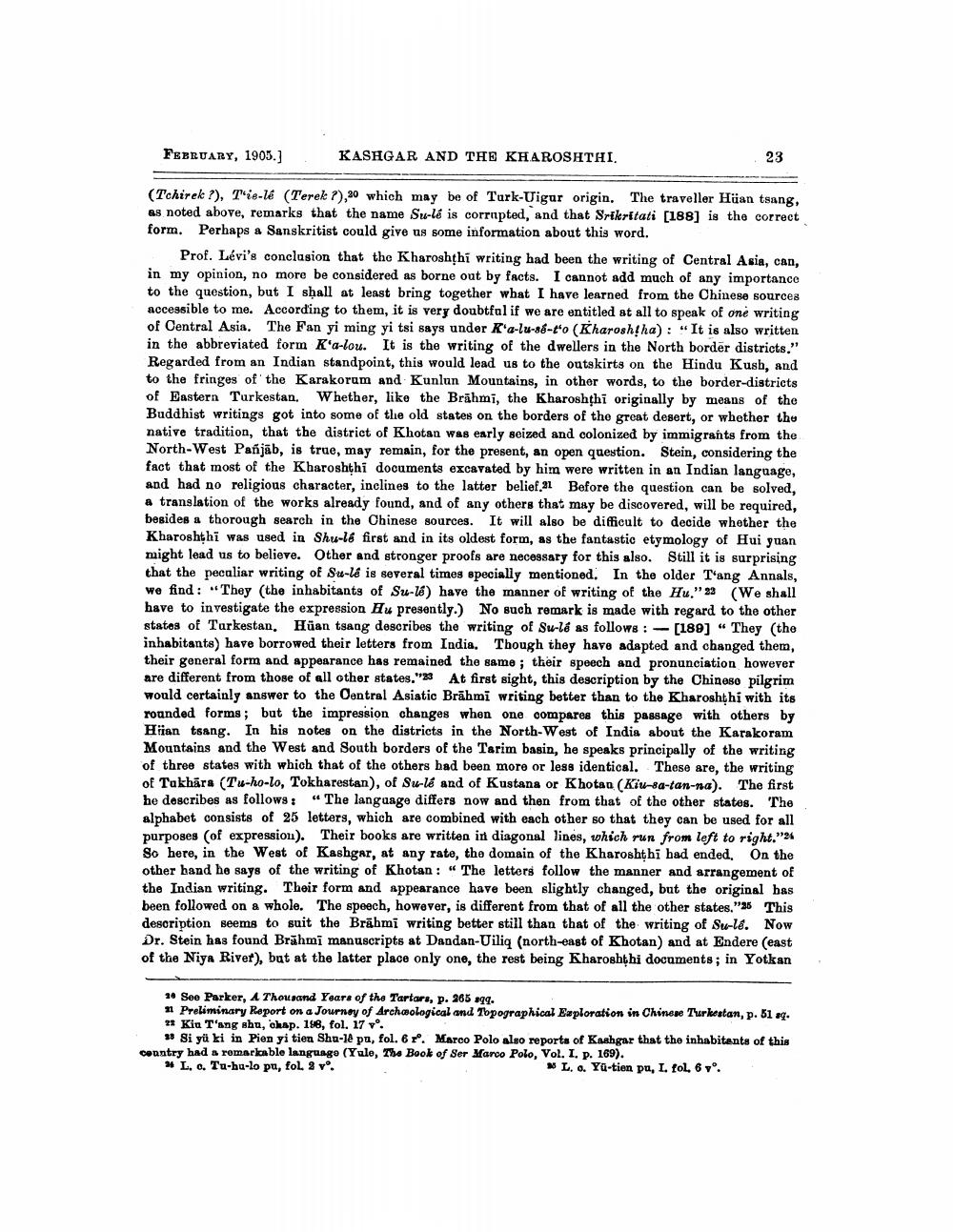________________
FEBRUARY, 1905.]
KASHGAR AND THB KHAROSHTHI.
23
(Tchirek ?), Tie-lé (Terek 7),20 which may be of Turk-Uigur origin. The traveller Hüan tsang, as noted above, remarks that the name Su-le is corrupted, and that Srikritati [188] is the correct form. Perhaps a Sanskritist could give us some information about this word.
Prof. Lévi's conclusion that the Kharoshthi writing had been the writing of Central Asia, can, in my opinion, no more be considered as borne out by facts. I cannot add much of any importance to the question, but I shall at least bring together what I have learned from the Chinese sources accessible to me. According to them, it is very doubtfal if we are entitled at all to speak of one writing of Central Asia. The Fan yi ming yi tsi says under R'a-lu-88-to (Kharosh!ha): “It is also written in the abbreviated form K'a-lou. It is the writing of the dwellers in the North border districts." Regarded from an Indian standpoint, this would lead us to the outskirts on the Hindu Kush, and to the fringes of the Karakorum and Kunlun Mountains, in other words, to the border-districts of Eastern Turkestan. Whether, like the Brāhmi, the Kharoshthi originally by means of the Buddhist writings got into some of the old states on the borders of the great desert, or whether the native tradition, that the district of Khotan was early seized and colonized by immigrants from the North-West Pañjāb, is true, may remain, for the present, an open question. Stein, considering the fact that most of the Kharoshthi documents excavated by him were written in an Indian language, and had no religious character, inclines to the latter belief.21 Before the question can be solved, a translation of the works already found, and of any others that may be discovered, will be required, besides a thorough search in the Chinese sources. It will also be difficult to decide whether the Kharoshthi was used in Shu-l6 first and in its oldest form, as the fantastic etymology of Hui yuan might lead us to believe. Other and stronger proofs are necessary for this also. Still it is surprising that the peculiar writing of Su-lé is several times specially mentioned. In the older Tang Annals, we find: "They (the inhabitants of Su-1) have the manner of writing of the Hu."22 (We shall have to investigate the expression El presently.) No such remark is made with regard to the other states of Tarkestan. Hüan tsang describes the writing of Su-lá as follows: - [189] " They (the inhabitants) have borrowed their letters from India. Though they have adapted and changed them, their general form and appearance has remained the same; their speech and pronunciation however are different from those of all other states."33 At first sight, this description by the Chinese pilgrim would certainly answer to the Central Asiatic Brāhmi writing better than to the Kharoshthi with its rounded forms; but the impression changes when one compares this passage with others by Hiian tsang. In his notes on the districts in the North-West of India about the Karakoram Mountains and the West and South borders of the Tarim basin, he speaks principally of the writing of three states with which that of the others had been more or less identical. These are, the writing of Takhara (T4-ho-lo, Tokharestan), of Su-lé and of Kustana or Khotan (Kiu-sa-tan-na). The first he describes as follows: “The language differs now and then from that of the other states. The alphabet consists of 25 letters, which are combined with each other so that they can be used for all purposes of expressiou). Their books are written in diagonal lines, which run from left to right."24 So here, in the West of Kashgar, at any rate, the domain of the Kharoshthi had ended. On the other hand he says of the writing of Khotan : "The letters follow the manner and arrangement of the Indian writing. Their form and appearance have been slightly changed, but the original has been followed on a whole. The speech, however, is different from that of all the other states. "26 This description seems to suit the Brāhmi writing better still than that of the writing of Sw-lá. Now Dr. Stein has found Brāhmi manuscripts at Dandan-Uiliq (north-east of Khotan) and at Endere (east of the Niya River), but at the latter place only one, the rest being Kharosht hi documents; in Yotkan
26 See Parker, A Thousand Years of the Tartars, p. 365 399. n Preliminary Report on a Journey of Archaological and Topographical Eaploration in Chinese Turkestan, p. 51 sq. 23 Kiu T'ang shu, chap. 188, fol. 17 v.
* Si yü ki in Pien yi tien Shu-le pu, fol. 6 ro. Marco Polo also reports of Kashgar that the inhabitants of this country had a remarkable language (Yale, The Book of Ser Marco Polo, Vol. I. p. 169). * L. o. Tu-hu-lo pa, foL 2 vo.
* L. o. Yu-tien po, L. fol. 6°.




